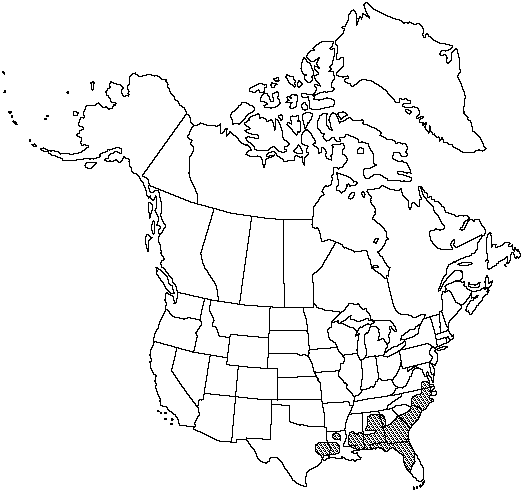Pinus palustris
Gard. Dict., ed. 8 Pinus no. 14. 1768.
Trees to 47m; trunk to 1.2m diam., straight; crown rounded. Bark orangebrown, with coarse, rectangular, scaly plates. Branches spreading-descending, upcurved at tips; twigs stout (to 2cm thick), orangebrown, aging darker brown, rough. Buds ovoid, silvery white, 3–4cm; scales narrow, margins fringed. Leaves (2) –3 per fascicle, spreading-recurved, persisting 2 years, 20–45cm × ca. 1.5mm, slightly twisted, lustrous yellow-green, all surfaces with fine stomatal lines, margins finely serrulate, apex abruptly acute to acuminate; sheath 2–2.5 (–3) cm, base persistent. Pollen cones cylindric, 30–80mm, purplish. Seed-cones maturing in 2 years, quickly shedding seeds and falling, solitary or paired toward branchlet tips, symmetric, lanceoloid before opening, ovoid-cylindric when open, 15–25cm, dull brown, sessile (rarely short-stalked); apophyses dull, slightly thickened, slightly raised, nearly rhombic, strongly cross-keeled; umbo central, broadly triangular, with short, stiff, reflexed prickle. Seeds truncate-obovoid; body ca. 10mm, pale-brown, mottled darker; wing 30–40mm. 2n =24.
Habitat: Dry sandy uplands, sandhills, and flatwoods
Elevation: 0–700m
Distribution

Ala., Fla., Ga., La., Miss., N.C., S.C., Tex., Va.
Discussion
Pinus palustris is fire successional, with a deep taproot and a definite grass stage. It is a valued species for lumber and pulpwood and was once important for naval stores (e.g., turpentine, pine oil, tar, pitch). It is fast disappearing over much of its natural range, partly through overharvesting but especially because of difficulties in adapting it to current plantation and management techniques.
Longleaf pine (Pinus palustris) is the state tree of North Carolina.
Selected References
None.
Lower Taxa
"relatively thin" is not a number.